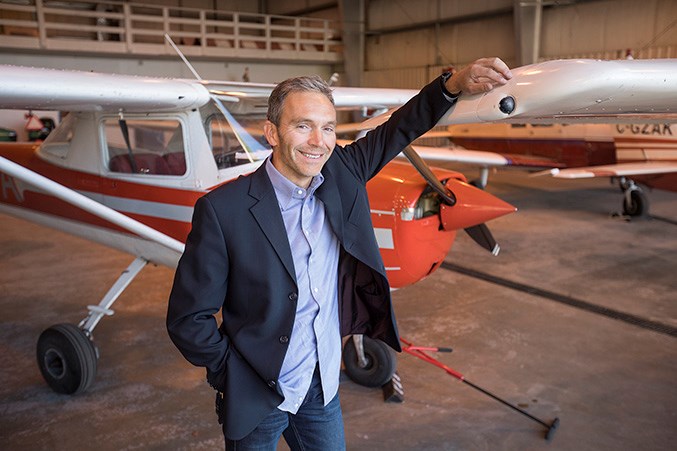Residents have raised concerns regarding the Calgary-Okotoks Flying School following a non-fatal plane crash on Aug. 8.
Complaints have stemmed from both safety and noise related concerns, with residents living near the Okotoks Air Ranch Airport citing the increased air traffic since the opening of the school earlier this year calling for changes to the school's operations.
Okotoks Mayor BIll Robertson said discretionary use was granted to the flying school, which helps sustain the airport as it is not viable with the hangar that currently occupies the flying school sitting empty.
“At the same time, there was certainly a change in the use of the airport,” he said. “I know that some people have indicated that they like the occasional plane flying in and out. The only trouble is that’s not going to sustain the airport, the revenue needed to pay the dues, so to speak.”
Because the flying school is a permitted discretionary use, Robertson said that while the Town could change the Air Ranch’s bylaw to take away the discretionary use, any pre-existing approved uses would be grandfathered out.
“We can’t shut down existing permitted uses because of a change in legislation, that would just open the Town up to litigation,” he said. “And we would lose, by all means, if we tried to shut it down.”
As the air ranch and flight paths are regulated by Transport Canada, Robertson said Town administration would propose a joint meeting with Transport Canada, the federal government with Foothills MP John Barlow, and the provincial government, with Highwood MLA RJ Sigurdson.
“We could sort of give a history, what is permitted there, and what the regulations are from Transport Canada,” he said.
Should the meeting be approved at the will of Okotoks Town Council, Robertson said he expected it would go ahead sometime in September.
“We want to allay people’s concerns and see if there is something to be done in terms of Transport Canada and the flight school,” he said. “Maybe the flight patterns can be changed. I can’t speak to that because I don’t know what regulations are in place and what mitigating factors there are… but that’s something we can certainly look into.”
Robertson said incidents at the Air Ranch are rare, and that in his research on the topic he found that flying is statistically safer than any other mode of transportation.
“That doesn’t allay people’s concerns about flying over their homes and so on, but I think if it’s researched, airplanes are a relatively safe way to travel,” he said.
The most recent incident at the Okotoks Air Ranch Airport preceding the crash earlier this month was in 2013, when a plane ran out of gas and landed in a farmer's field—coincidentally, the same farmer’s field as the newest incident.
While the Transportation Safety Board (TSB) is still investigating the Aug. 8 crash, Tim Ulmer, owner of the flying school, said the crash was pilot-error, after mechanics found no mechanical issues with the plane and determined it was functioning normally.
“So it’s classified by Transport Canada as a training incident, so you might as well call it pilot error. But as in all things, whatever you’re learning, humans make mistakes,” said Ulmer. “… Obviously every incident, whether it’s good or bad, we always take it as an opportunity to learn. It’s something to be taught to the pilots involved as well as the other students and pilots in the school.”
The plane landed in a farmer’s field after takeoff, and sustained minor damage to the main landing gear, and moderate damage to the engine area.
Both the instructor and student were uninjured in the crash, and Ulmer said he expects the plane will be back in rotation at the school in the next four weeks.
Ulmer said there is a significant amount of regulatory control over the airport and the school, which have to meet strict federal guidelines to operate.
The airport and zoning was in place in Okotoks long before the community’s were built, he said, and there has always been a flying school at the Air Ranch, in some variation.
Admitting that the current flying school is likely busier than the past ones, Ulmer said the increased traffic at the flying school is two parts: the populations have increased dramatically since 1978, and there is a global pilot shortage.
“Right now, worldwide, there is a huge shortage of pilots, flights are being cancelled,” he said. “It’s a two-year waiting list to get into a flight school in Calgary right now, which means you’re not creating any qualified pilots to start looking for jobs for at least five years.”
At the Calgary-Okotoks Flying School, there is a maximum four-month “waiting list,” said Ulmer, owing to the university-style semesters offered, and typically take between 16 and 24 students per semester.
The air traffic through the school is dependent on where the students are in their training, said Ulmer, with the majority (75 per cent) being done outside of town limits, east of Highway 1.
However, when the students are in circuit training (learning takeoffs and landings), Ulmer said they do a number per hour for practice.
Depending on weather, wind, and what exercise is being completed, he said the circuit training would be done in High River as well.
Because of the semester-style courses, he said the students often hit the same part of their training at the same time, contributing to the increased air traffic—four or five students could be doing circuit training in the same week.
“It’s kind of funny because it will go in spurts: we’ll hear residents saying ‘hey, you’ve been really quiet, we haven’t heard airplanes for the last couple of weeks, and now all of a sudden we’re hearing them everyday,’” he said. “… And then for the next month they’ll be out in the practice area and you won’t hear them.”



